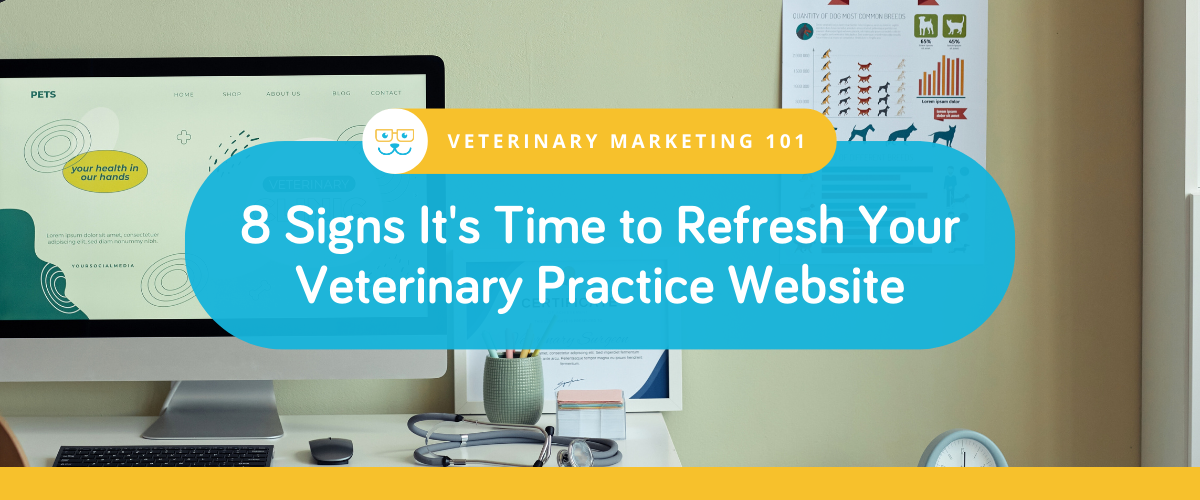8 Signs It's Time to Refresh Your Veterinary Practice Website
Your veterinary practice's website is one of your most valuable digital marketing tools – or at least it should be. While almost every veterinary practice has a website, not all are as effective as they could be. Veterinarians are animal medical experts, after all, and we shouldn't expect them to also have web design and development expertise listed on their resumes.
But, when veterinarians try to build and maintain websites on their own or partner with third parties that develop your site and then move on, problems will eventually arise, and practices can be left with unattractive, outdated, and uninspired websites.
If your website is struggling to draw traffic or patients have complained about it being difficult to find your information online, it's time to make some changes. To help you evaluate what's working and what's not, we've outlined 8 of the most common signs that it's time to give your website some love and a good refresh.
1. Outdated Design and Aesthetic
If visitors click onto your site and they’re greeted with pixelated clip art or a gray, blocky interface straight out of the early 2000s, you’ve got a problem. While an effective website doesn’t need to be wildly expensive and feature top-of-line design elements, a little extra consideration of the aesthetic and overall design of a veterinary website can go a long way. Better aesthetics on your veterinary website can result in visitors overlooking minor usability issues on your site and being more likely to stay on your site as opposed to a competitor’s. In fact, it’s reported that 38% of people will stop engaging with a website if the content or layout are unattractive.
This is due to the way perceived attractiveness of something, like a webpage, can influence how a user interacts with and values that object. Commonly referred to as the Aesthetic-Usability Effect, this phenomenon is a key consideration in web design, as “users often perceive aesthetically pleasing design as design that’s more usable,” according to the Laws of UX.
While striking a balance between aesthetic and functionality can be a challenging task – especially for those creating engaging and informative veterinary websites – it’s also equally rewarding for the impact it has on a visitor’s overall impression of your practice. An outdated aesthetic reflects poorly on your professionalism and sends the message that your practice may not keep up with modern veterinary standards or the latest and greatest in technology.

2. Your Brand Has Changed, But Your Website Hasn’t
If you've been in business for a while, it's likely that your brand has evolved over the years. However, as some veterinary practices update their logos, color schemes, value propositions, and service offerings, those changes are sometimes not reflected on their website. This is where problems can arise.
Good branding requires consistency, and that includes consistency on your website. Having different branding and messaging on your website than you do on social media or on physical marketing assets can create a major disconnect between you and potential patients. Your website should always feature your most current brand messaging, value propositions, and practice mission while speaking to your ideal patient and their pain points as they stand today.
Remember, your website is a crucial marketing tool and should easily reflect the current state of your brand to foster a greater sense of recognizability and credibility for your practice.
3. Poor or Confusing UX
When users visit your website, it should be easy for them to find what they're looking for, and major information hubs, like your service pages or team information, should be accessible from logical and familiar locations, like a top-of-page navigation bar. If your key business information is buried within your website's taxonomy, and it takes multiple minutes for users to figure out how to navigate to the correct page, you likely have a problem with your site's User Experience (UX).
Poor UX on a veterinary practice website can have significant repercussions, negatively impacting a practice's online presence, reputation, and ability to attract and retain patients. UX issues can often arise on well-established or older sites that have been frequently added to over the years. As practice owners build on their websites and add new pages, it's easy to fall into the mindset that more is better. But, when it comes to web design and UX, an overload of information and too many pages in a navigation bar can do more harm than good and create unnecessary confusion.
When in doubt, it's best to highlight your most important information in upper navigation schemes and make supporting resources as accessible and easy to find as possible within those main information hubs. And don't forget about clear and concise calls to action! Good and easily recognizable CTAs contribute to positive UX by showing users exactly what action you want them to take and where they complete it.
4. High Bounce Rates and Low Conversion Rates
Routinely analyzing your website's overall performance and digging into specific key performance indicators (KPIs) and metrics can be incredibly valuable for assessing whether or not your current website is effectively driving the traffic and leads needed to sustain or grow your practice. Bounce rate and conversion rates are key metrics that can give you insights into how users are responding to and interacting with your veterinary website.
- Bounce rate is the percentage of website visits that resulted in just one pageview. For example, if two people visit your site, with one person only visiting your homepage, then closing the browser, and the other visiting your homepage, then clicking through to your contact page, your bounce rate would be 50%.
- Conversion rate tells you how well your website is optimized in terms of sending users toward the desired conversion actions, like scheduling an appointment or filling out a form.
If you have a recent track record of higher bounce rates and/or low conversion rates, it's time to take a look at your site, determine what issues are causing these low performances, and correct them.

5. Sluggish Site Speed
The internet is a place of instant gratification; internet users know what they want, and they know they want it now. User expectations are high when it comes to speed and page load times, and if your site is sluggish and slow to respond, visitors won't hesitate to hit the back button and explore other options. If you have an older site or a site that's maxed out with large image or video files that take forever to load, you're likely unintentionally driving away potential patients and hurting your own practice's marketing and growth efforts.
But users navigating away from a slow-loading page shouldn't be your only concern, as poor page speed can have other negative impacts. Slow loading speeds not only frustrate potential clients but also negatively impact your search engine rankings. Google considers page speed, or how fast the content of your web page is able to load, as a ranking factor, meaning a sluggish website could be burying your practice in search results.
6. Poor Search Engine Visibility or Misaligned Keywords
If SEO and keyword rankings haven't previously been a focus of your marketing efforts, then there's a good chance that your search engine rankings aren't stellar, and some of the keywords you do rank for are misaligned with your goals and don't drive the right type of traffic. If your veterinary practice website is buried on the fifth page of search results while your competitors enjoy prime real estate on the first page, it's time to make some changes.
Redesigning your veterinary website creates an ideal opportunity to restructure and fill out your website in a way that is beneficial for both UX and SEO, which go hand-in-hand. When refreshing your website, you can conduct a thorough SEO audit to identify areas for improvement. To get the best results from your refresh, ensure that your website is optimized for relevant keywords, has proper meta tags, and follows best SEO practices. An effective SEO strategy not only boosts your search rankings but also attracts organic traffic, increasing your chances of turning website visitors into returning clients.
While a website redesign can sometimes result in a small, short-term drop in traffic or keyword positions due to new content and altered site pages, the long-term impacts of a website redesign or refresh are well worth it, and you may need to adopt a "trust the process" mindset for a few weeks!

7. Lack of Mobile Responsiveness
Tech ownership has increased dramatically over the past two decades, and now, just about everyone has a smartphone. According to research from Consumer Affairs, approximately 92% of Americans own a smartphone, and the time we spend on it throughout the day is staggering. Americans spend an average of 4 hours and 25 minutes on their phones per day and check their devices up to 144 times in that period.
With millions of people having near immediate access to the internet at any time of day, if your website doesn't prioritize mobile responsiveness, you're alienating a significant portion of potential clients.
In fact, HubSpot reports that "53.8% of web designers cite 'not being responsive on all devices' as a top reason for a website to be redesigned." Data from Goodfirms further supports the idea of mobile responsiveness being a crucial priority for business websites, reporting that 73.1% of 200 surveyed web designers believe that non-responsive design was one of the largest contributing factors to visitors leaving a website without engaging or converting.
8. Your Competitor’s Websites Are More Impressive
Remember, your website is the online face of your business and no matter how good your services are, if your website is old, confusing, or unresponsive, you could be losing out on local business to a competitor who made a better online impression. If you want to remain competitive in the veterinary digital marketing arena, your website needs to be regularly maintained and updated with the latest web design, content, and SEO best practices.
While it's important to remember that every veterinary practice is unique and their marketing practices may differ depending on the practice's needs and goals, it's never a bad idea to stay aware of what your competitors are doing and what their marketing assets – website included – look like and how well they function in comparison to your own. By understanding what your competitors do well, as well as what areas they may struggle in, you can create a marketing plan and comprehensive website that plays to your own strengths and addresses competitor shortcomings.
Let the Best in the Business Lead Your Website Redesign
First impressions matter. Don't let an outdated website impede your marketing efforts and practice growth; invest in an attractive and functional website that sets your veterinary practice apart in the digital landscape.
Schedule a demo with the GeniusVets team to learn about our veterinary website services and how they can elevate your practice's online presence.

